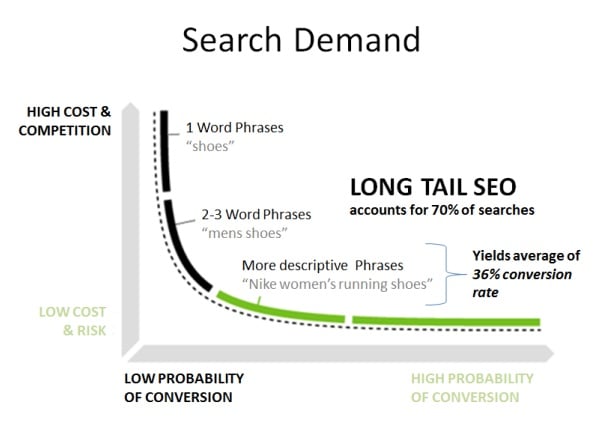4 E-commerce Trends in 2026
What will the biggest e-commerce trends be in 2026? Artificial Intelligence will clearly play a big role. We explore those trends with 4 predictions.

Everyone who’s ever used Google knows about keywords. If you run an online shop, then you know how important keywords are for getting traffic to your website. If you're still relatively new to SEO, there's a concept you should familiarise yourself with called long tail keywords. If this concept is new to you, make sure you keep reading because they are the “key” for smaller businesses to compete with the big boys and getting more traffic to your site.
Generally speaking, keywords are the most essential part of any SEO strategy. Getting the right keywords spread throughout your website, your product pages, and your blog can help you rank high on Google, which is invaluable.
First thing’s first. What exactly is a long tail keyword? If you use Google in your personal life, then you’ve definitely used them before.
Long tail keywords are basically multi-word search terms (three words or longer). Because they are longer phrases, they are searched for less often than shorter search terms (usually referred to as "head keywords"), but are generally more specific to the user's intent.
Search volumes for long tail keywords are far lower than for head keywords, which might sound like a negative, but what it really means is that this search terms is way more targeted and therefore, more relevant to the user. This can create a great opportunity for content creators to drive traffic to their page.
The chart below from Neil Patel’s website does a great job explaining what long tail keywords are and how it got its name. At the “head” of the chart, you’ll see the most popular search terms (the top 10K keywords). Being the most popular means there are literally millions of searches for these keywords every month. This is where you can find head keywords such as "sneakers", "jackets", etc.

Competing for these "head words", whether paid or organically, is going to be very difficult.
Organically speaking, you’ll have thousands of websites to compete against. Think about it: A simple search term like “smartphone” is going to show up everywhere on the internet from review sites to news sites to online shops. How can you expect to rank highly there? As a small business owner, it’s nearly impossible.
From a paid ads perspective, targeting these “head keywords” is going to be expensive and probably not very effective. If you’re paying to get your Google ads to rank for the search term “smartphone”, do you know exactly what the user’s intent is when they click on your ad? Are they looking to buy a smartphone? Are they looking for news about upcoming smartphones? Are they looking for accessories?
The search term in this case is so vague, that it would be fair to assume that a large number of people who click on your ad are going to be irrelevant, and thus you’ll be paying for an expensive click that won’t lead to a conversion. Not only that, but if Google determines that your ad is irrelevant to the keyword you bid on (due to a high bounce rate), those expensive clicks get even more expensive.
As you move further down the chart, you’ll find the long tail keywords (at the “tail” end of the chart). They account for 70% of online search traffic! Not only that, but because there is much less competition, it will be much easier to rank organically, much cheaper to bid for Google Ads, and best of all, much more relevant for users.
So, if your shop sells phone cases, it simply makes much more financial sense to target terms like “Samsung Galaxy S9 smartphone case” than it does to target “smartphone”.
Below is a similar chart from neilpatel.com that gives examples of these search terms, and breaks down how costs go down for less competitive keywords and the probability of conversions goes up as you move down the X-axis.

The further you go down the X-axis, the more specific the search term is, and the cheaper/easier it is to rank for these terms both organically and for paid ads. This is actually the perfect strategy for any companies that target a very specific niche market.
The first step to finding the right long tail keywords is to get into the mind of your target audience. Whenever you write a blog or create a landing page, you need to think like your ideal customer. If you’ve been doing business for some time, you probably have an idea of who your ideal customer is.
By doing research on your sales and your industry, you should be able to write a description of the typical traits your ideal customer has. In fact, this is a very common practice in the marketing world. It’s called creating a customer persona (a.k.a. marketing persona or buyer persona).
It can be extremely helpful to write a customer persona and refer to it when writing anything for your website. This description usually includes information on the gender, age, occupation, financial status, hobbies and interests of this ideal customer.

Shutterstock/OndrejProsicky
Once you know who your target audience is, how they behave, and how they search, you’ll have a better understanding of what keywords and terms they will use when they are searching for a product that you can sell them.
After you’ve created your customer persona, you’ll want to do some actual keyword research. If you’ve created advertisements on Google Ads before, you’ll have access to Google’s Keyword Planner.

From the Keyword Planner, you’ll have the option to get some suggestions for similar keywords that you’re aiming at.

Once you get to this page, you can get some other suggestions for similar keywords. What’s great about this tool is that you can see the average cost per click (CPC) for each search term and also get a feeling for the competition. Even if you don’t create an ad with Google, this can help you get a feeling for how difficult it is to rank for a specific search term organically.
The list goes on and on with suggestions for similar keywords, so take your time and take some notes.
There are a lot of great tools out there to help you with search terms. KWfinder is a popular option out there. Similarly to Google’s tool, KWfinder gives you lots of suggestions to similar search terms, while also giving you a “Keyword difficulty score” for most terms, which is an indicator for how hard it is to rank for this term organically.
The PPC score indicates how much competition you’ll have for winning this bid in Google Ads.
Click on the image to enlarge it.
Notice that the term “smartphones” gets 9,000 searches per month in the UK and a has a "difficulty score" of 53 and a CPC of $1.76. After performing a quick search and filtering by search volume, I found a comparable, more specific search term.
Although they are both highly competitive for Google Ads (PPC score of 100), “Cheap mobile phones” has a search volume of 22,200, a difficulty score of 39 (meaning it’s easier to rank), and a cheaper CPC ($1.65).
On top of that, the search term itself (specifically the word "cheap"), is more indicative of someone who has the intent to buy a phone. All in all, it makes much more sense to target this search term than the generic “smartphones” keyword.
There are a few other tools that are available to use. Neil Patel has released a free tool on his website called ubersuggest. It works very similarly to KWfinder and Google’s Keyword Planner.
Answerthepublic is a great tool for figuring out what questions people ask when it comes to certain search terms. This can be helpful when figuring out blog titles or headlines within your blog.
In the image above from answerthepublic, we see what questions show up in search engines that include the word "sneakers" (Click on the image to enlarge)
Otherwise, you might want to consider some other simple strategies such as Google’s autocomplete feature when you start typing in the search box. Similarly, you could search a keyword, and in the results page, check out their “related search terms”.

The related search terms function of a standard search can be helpful for your SEO research.
You could also head to industry forums, Quora, or reddit to see what kind of topics people are talking about, what questions they are asking, what trends are emerging, and what lingo they are using.
If your shop collects reviews (or if your competitor does), you might get some insights into the customer’s mind here. Naturally, there are other benefits to having a review system on your website as well, (yes, they can really benefit your SEO strategy as well!).
By now, you’ve figured out that these long tail keywords are to get traffic to your site. You’ll be using these keywords in your blog, product pages, and landing pages to give organic strength to your website.
When creating content, be sure to use these words in a natural way. Don’t over-stuff your articles and pages with keywords because Google is smarter than that! They will penalise your website for “keyword stuffing”, a tactic that was used by many “shady” websites during Google’s early days.
Using keywords is definitely important, but as Google is constantly improving their algorithms and getting “smarter”, keep in mind that your content needs to add real value to the reader. Google is learning to find content relevant to search terms even if those words or phrases aren’t exactly in the page’s meta description, so be sure that your content is of high quality and brings value to your readers.
Using long tail keywords can be a really effective SEO strategy if done correctly. By focusing on longer search terms that have lower costs, higher conversion rates, and are more targeted/relevant to your audience, you can make the most of your marketing budget and polish your SEO strategy to get you on the first page of Google’s search results!
05/11/21What will the biggest e-commerce trends be in 2026? Artificial Intelligence will clearly play a big role. We explore those trends with 4 predictions.
SEO is an important tool for e-commerce businesses to bring in new customers. Here are the best tips for your online shop to rank higher in Google.